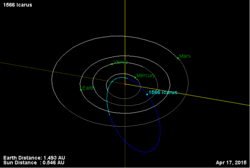1566 Icarus
1566 Icarus is an Apollo asteroid (a sub-class of near-Earth asteroid). At its closest approach to the Sun (perihelion) it is closer to the Sun than Mercury. In its orbit it crosses the orbits of Mercury, Venus and Mars. It is named after Icarus of Greek mythology, who flew too close to the Sun. The asteroid was found in 1949 by Walter Baade.
| Discovery | |
|---|---|
| Discovered by | Walter Baade |
| Discovery date | June 27, 1949 |
| Designations | |
| 1949 MA | |
| Orbital characteristics | |
| Aphelion | 294.590 Gm (1.969 AU) |
| Perihelion | 27.923 Gm (0.187 AU) |
| Eccentricity | 0.827 |
| 408.778 d (1.12 a) | |
| Physical characteristics | |
| Dimensions | 1.4 km |
| Mass | 2.9×1012 kg |
Mean density | 2 ? g/cm³ |
| 0.000 39 m/s² | |
| 0.000 74 km/s | |
| 0.094 71 d | |
| Albedo | 0.4[1] |
| Temperature | ~242 K |
| 16.9 | |
Icarus makes a close approach to Earth at gaps of 9, 19, or 38 years. Sometimes, it comes as close as 6.4 Gm (16 lunar distances and 4 million miles), as it did on June 14, 1968. The last close approach was in 1996, at 15.1 Gm, about 40 times as far as the Moon.[2] The most recent close approach was on June 16, 2015, 8.1 Gm (5 million miles).
In 1967, Paul Sandorff of the Massachusetts Institute of Technology gave his students the task of making a plan to destroy Icarus, if it was going to hit the Earth. This plan is known as Project Icarus[3] (which was the basis for the 1979 science fiction film Meteor, starring Sean Connery).
1566 Icarus Media
References
- ↑ Radiometry of near-earth asteroids
- ↑ "Page Modified". Archived from the original on 2004-11-02. Retrieved 2009-03-03.
- ↑ Project Icarus, MIT Report No. 13, MIT Press 1968, edited by Louis A. Kleiman. "Interdepartmental Student Project in Systems Engineering at the Massachusetts Institute of Technology, Spring Term, 1967".
Other websites
- NeoDys Object Listing: orbital elements and list of close approaches
- Article on TheSpaceReview.com about Project Icarus
